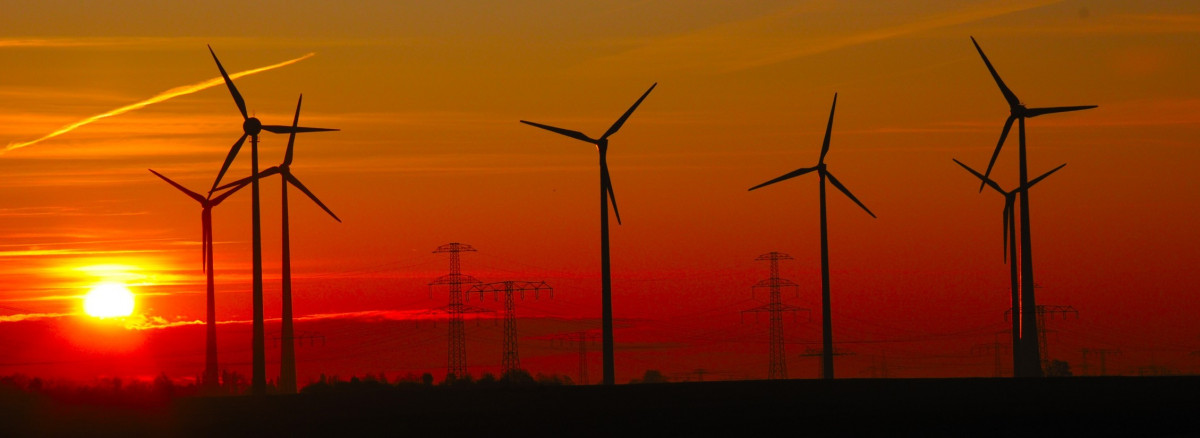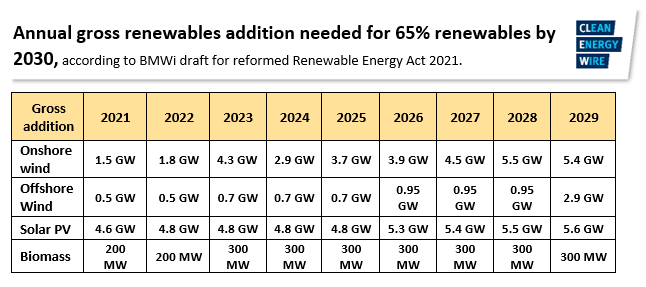Ministry plans renewables expansion push to reach Germany's 2030 target
Germany will increase the renewable energy capacity added each year to ensure that the country is on track for greenhouse gas neutrality by the middle of the century as well as the 2030 target, the draft reform of the Renewable Energy Act (EEG) states. The economy ministry document, seen by Clean Energy Wire, also provides new financing options for old solar PV units which could otherwise cease to operate after their 20-year funding runs out. Industry associations warned that the current renewables growth path is not aligned with increased power consumption in the future and a tougher EU climate target.
"With the new EEG our electricity will become 100 percent climate neutral," said economy minister Peter Altmaier in a message on Twitter. The draft, dubbed "EEG 2021", stipulates that all electricity produced in Germany by 2050 would be generated in a greenhouse gas neutral way. In order to prevent greenhouse gas emissions from being caused by electricity imports, all electricity consumed in Germany should also be generated in a greenhouse gas neutral manner, and the draft says that the government will work to ensure that corresponding regulations are adopted across Europe.
Germany’s renewables legislation, which came into effect 20 years ago, is responsible for the significant growth in onshore wind, solar PV, and biogas by guaranteeing generous feed-in tariffs. Together with offshore wind and hydro power, these renewables sources now cover half of the country’s electricity consumption. Subject to various changes in the past, the EEG’s next overhaul - to be effective as of January 2021 - is staying true to its basic principles of making renewable power producers more market-ready by sticking to renewable tenders while incorporating new developments such as the 2020 national hydrogen strategy and electricity prices for e-car charging. By 2027, the government wants to propose how, and by when, renewables funding via the EEG could be stopped entirely – provided a market-driven renewables expansion is to be expected.
The ministry suggests increasing the solar PV capacity to 100 GW (~52 GW today), onshore wind to 71 GW (55 GW today), biomass to 8.4 GW, and offshore wind to 20 GW - targets that slightly exceed those from the Climate Action Programme 2030, which was decided late last year. The law sticks to annual deployment targets to make sure that capacity addition is compatible with the 65-percent-renewables target and allows for the adjustment of the power grid to incorporate the growing amount of fluctuating renewables input.
German renewables targets would be adjusted if EU decides more ambitious 2030 climate goal - minister
Industry associations BDEW, BNE and BEE all warned in the past weeks that the government’s targets were based on unrealistic power consumption estimates, because more electricity would be needed in the future for e-mobility, green hydrogen production and electrifying the heating sector. German Solar Association (BSW) warned that fossil and nuclear plants would inevitably have to run longer to make up for the missing power without a faster deployment of renewables. Renewables association BEE had suggested a more ambitious growth path of 4.7 GW onshore wind, 2 GW offshore wind, 10 GW solar PV and 600 MW biomass annually to reach the 2030 target.
Currently, both onshore wind and biogas additions were lagging behind, while around 17,000 MW of wind and solar capacity could be retired in the next five years due to a missing system for follow-up remuneration after their 20-year-funding runs out as of next year. “We need to adjust the annual targets for renewables expansion upwards and find a good interim solution for the old installations,” BEE president Simone Peter has said.
The bioenergy industry criticised the draft for failing to achieve what is postulated by the Climate Action Programme 2030. The proposal included the target of 8.4 GW of bioenergy but the planned tender volumes did not reflect this, Sandra Rostek said on behalf of four German bioenergy organisations. “What is outlined now results in a dismantling path that neither stimulates new construction nor preserves the existing stock,” she said in a press release.
Kerstin Andreae, head of energy industry association BDEW, said the draft lacks the “necessary push” for solar power. “That applies in particular to the large potential, which for solar energy lies on so far unused rooftops. In order to finally bring solar energy to the cities, more courage would have been needed,” said Andreae.
If the EU decides on a new 2030 climate target, the German renewables targets would also have to be adjusted, analysts have warned. In this case, tender volumes could be adjusted according to current electricity consumption forecasts, the draft law reads, suggesting a first review in 2023.
The German government would indeed increase the renewables expansion targets, should the decision for a more ambitious EU 2030 climate target make this necessary, economy minister Peter Altmaier told tageszeitung (taz) in an interview. He added to preserve Germany’s industrial foundation, “we need 100 percent renewable electricity by 2050.”
The German Association of Local Utilities (VKU) called the draft a “solid foundation” for the upcoming reform, because it defines concrete expansion paths. However, managing director Ingbert Liebing said higher future power consumption should be assumed already. “An evaluation in 2023 is a comprehensible approach. However, this must not mean that the necessary discussion about a market design that enables climate neutrality is postponed until then,” he said, and added that a comprehensive reform of energy taxes and levies would have to be tackled in the next legislative period.
Environmental Action Germany's (DUH) managing director Sascha Müller-Kraenner fundamentally criticised the renewables targets and said greenhouse gas neutrality of the power sector only by 2050 is insufficient to reach Paris Agreement goals. “This is why we need a 75 percent share of renewable energies by 2030, not 65 percent as proposed by the economy ministry in its draft.”
Interim solution for pioneer installations
The proposal includes an interim solution for the small solar PV installations (up to 100 kW) that will stop receiving payments in the 2020s because their 20-year funding period runs out. Marketing the power from these very small installations would not be economically viable for their owners. But to prevent them from being deconstructed or from feeding in their power “wildly”, they will be given an interim remuneration for their electricity until 2027, amounting to the market value minus marketing costs.
Old onshore wind turbines, of which some 16 gigawatt could be decommissioned by 2025, are not going to benefit from this rule since even the oldest and smallest ones rarely have a capacity of under 100 kW. They do however retain their feed-in priority over conventional power sources and can therefore remain connected to the grid and market their electricity themselves.
Some gaps to fill – ministry aims to incorporate hydrogen
The proposal is not yet complete. In line with its new hydrogen strategy, the government wants to exempt producers of green hydrogen from having to pay the renewables surcharge on the power they use (and at the same time prevent power from getting more expensive for everyone else). But this aspect would have to be added later because the stakeholder dialogue on this point was still ongoing, the ministry writes.
Klaus Müller from the Federation of German Consumer Organisations (VZBV) commented that such exemptions for hydrogen, industry and shipping must not increase the power price for the average consumer, adding that these exemptions had to be tax-financed instead.
More wind turbines in the south
To incentivise wind expansion in (less windy) southern Germany, the proposal introduces a “quota for the south” (15% of successful tenders have to come from the south between 2021-2023 and 20% as of 2024). It also guarantuees communities which allow wind parks to be build a share of the park’s income. The idea is to ensure a more balanced wind power expansion so that not all generating capacity is in the north of the country, which would have negative implications if north-south grid connections are not completed in time before nuclear power stations in the power-hungry south are shut down.
In return, the proposal gets rid of the so called “grid congestion zones”, areas (mostly in the North of Germany) where onshore wind expansion had to be smaller because a high input of more renewable power would have likely caused grid problems. The ministry says that this instrument did not work “for several reasons”.
The energy ministry’s draft is now in the process of inter-ministerial consultation and is scheduled to be discussed in the government cabinet at the end of September. Afterwards parliament will have its say and cast the final vote on the reform.



